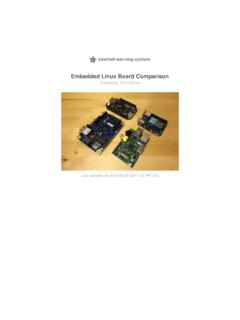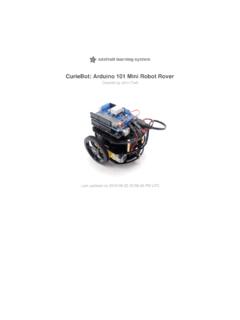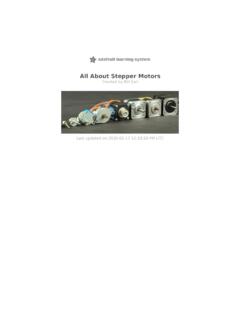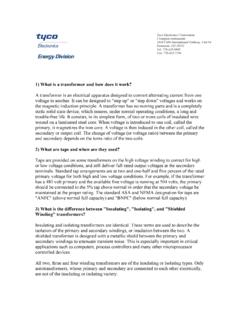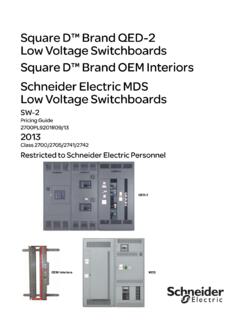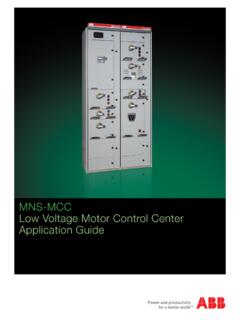Transcription of Adafruit Motor Shield V2 - Adafruit Industries
1 Adafruit Motor Shield V2 Created by lady ada updated on 2021-11-22 09:40:54 AM EST Adafruit IndustriesPage 1 of 4957121215151921212222222426272727272828 2828292930303031313131313132323233343434 353636 Table of ContentsOverviewFAQI nstall Headers & Terminals Installing Standard Headers Installing Terminal Blocks and more Installing with Stacking HeadersInstall Software Install Adafruit Motor Shield V2 library Running the Example Code DC Motor Stepper Motor TestLibrary Reference class Adafruit_MotorShield; Adafruit_MotorShield(uint8_t addr = 0x60); void begin(uint16_t freq = 1600); Adafruit_DCMotor *getMotor(uint8_t n); Adafruit_StepperMotor *getStepper(uint16_t steps, uint8_t n); void setPWM(uint8_t pin, uint16_t val);void setPin(uint8_t pin, boolean val); class Adafruit_DCMotor Adafruit_DCMotor(void); void run(uint8_t); void setSpeed(uint8_t); class Adafruit_StepperMotor Adafruit_StepperMotor(void); void step(uint16_t steps, uint8_t dir, uint8_t style = SINGLE); void setSpeed(uint16_t); uint8_t onestep(uint8_t dir, uint8_t style); void release(void);Arduino Library DocsPowering Motors Voltage requirements: Current requirements: Setting up your Shield for powering Hobby Servos Setting up your Shield for powering DC and Stepper Motors If you would like to have a single DC power supply for the Arduino and motors If you would like to have the Arduino powered off of USB and the motors powered off of a DC power supply If you would like to have 2 separate DC power supplies for the Arduino and motors.
2 Using RC Servos Powering ServosUsing DC Motors Connecting DC Motors Adafruit IndustriesPage 2 of 4936373737373738393939393940404142424344 454546474848 Include the required libraries Create the Adafruit_MotorShield object Create the DC Motor object Connect to the Controller Set default speed Run the motorUsing Stepper Motors Include the required libraries Create the Adafruit_MotorShield object Create the stepper Motor object Set default speed Run the motorPython & CircuitPython CircuitPython Microcontroller Wiring CircuitPython Installation of MotorKit and Necessary Libraries CircuitPython Usage DC Motors Stepper Motors Full Example CodePython DocsStacking Shields Addressing the Shields Writing Code for Multiple ShieldsResources Motor ideas and tutorials Adafruit IndustriesPage 3 of 49 Adafruit IndustriesPage 4 of 49 Overview The original Adafruit Motorshield kit is one of our most beloved kits, which is why wedecided to make something even better.
3 We have upgraded the Shield kit to make thebestest, easiest way to drive DC and Stepper motors. This Shield will make quick workof your next robotics project! We kept the ability to drive up to 4 DC motors or 2stepper motors, but added many improvements:Instead of a L293D darlington driver, we now have the TB6612 MOSFET driverswith per channel current capability (you can draw up to 3A peak for approx 20msat a time). It also has much lower voltage drops across the Motor so you get moretorque out of your batteries, and there are built-in flyback diodes as of using a latch and the Arduino's PWM pins, we have a fully-dedicated PWMdriver chip onboard. This chip handles all the Motor and speed controls over two GPIO pins (SDA & SCL) plus 5v and GND. are required to drive the multiplemotors, and since it's I2C you can also connect any other I2C devices or shields tothe same pins. This also makes it drop-in compatible with any Arduino, such as theUno, Leonardo, Due and Mega stackable design: 5 address-select pins means up to 32 stackable shields:that's 64 steppers or 128 DC motors!
4 What on earth could you do with that manysteppers? I have no idea but if you come up with something send us a photo becausethat would be a pretty glorious project. Adafruit IndustriesPage 5 of 49 Lots of other little improvements such as a polarity protection FET on the power pinsand a big prototyping area. And the Shield is assembled and tested here at Adafruitso all you have to do is solder on straight or stacking headers and the terminal check out these specs again:2 connections for 5V 'hobby' servos connected to the Arduino's high-resolutiondedicated timer - no jitter!4 H-Bridges: TB6612 chipset provides per bridge (3A for brief 20ms peaks)with thermal shutdown protection, internal kickback protection diodes. Can runmotors on to to 4 bi-directional DC motors with individual 8-bit speed selection (so, resolution)Up to 2 stepper motors (unipolar or bipolar) with single coil, double coil,interleaved or automatically disabled on power-upBig terminal block connectors to easily hook up wires (18-26 AWG) and powerArduino reset button brought up topPolarity protected 2-pin terminal block and jumper to connect external power,for separate logic/ Motor suppliesTested compatible with Arduino UNO, Leonardo, ADK/Mega R3, Diecimila &Duemilanove.
5 Works with Due with logic jumper. Works with Mega/ADK R2and earlier with 2 wire the easy-to-use Arduino software library, check out the examples andyou're ready to go!5v or compatible logic levels - jumper configurable. Adafruit IndustriesPage 6 of 49 FAQ How many motors can I use with this Shield ?You can use 2 DC hobby servos that run on 5V and up to 4 DC motors or 2 steppermotors (or 1 stepper and up to 2 DC motors) that run on 5-12 VDCCan I connect more motors?Yes, by stacking shields! Every Shield you stack on will add 4 DC motors or 2stepper motors (or 1 more stepper and 2 more DC motors). You will not gain more servo connections as the servo contacts go to pin #9 and#10 on the if I also need some more servos?Check out our lovely servo Shield , also stackable with this Motor Shield and adds16 free-running servos per Shield ( )What Arduinos is this Shield compatible with?
6 It is tested to work with Duemilanove, Diecimila, Uno (all revisions), Leonardo andMega/ADK R3 and higher. It can work with Mega R2 and lower if you solder a jumper wire from the Shield 'sSDA pin to Digital 20 and the SCL pin to Digital 21 For use with the Due or other processors, you must configure the board logic levels. Find the set of 3 pads labeled "Logic". Cut the small tracebetween the center pad and 5v and add a jumper from to the of Arduino BETA, there is a bug in the Due Wire library that prevents multiple Motor Shields from working properly with the Due! As of Arduino BETA, there is a bug in the Due Wire library that prevents multiple Motor Shields from working properly! Adafruit IndustriesPage 7 of 49I get the following error trying to run the example code:"error: : No such file or "Make sure you have installed the Adafruit_MotorShield libraryHow do I install the library?Check the tutorial page on the subject here ( )What stepper motors can I used with the Shield ?
7 The TB6612B driver chip are simple H-bridge drivers with a continuous currentlimit. There is no active current limiting, so you need to choose a stepper motorthat will not try to pull more than that. For a detailed explanation, see thisguide ( )A simple rule of thumb is to use a Motor with a phase resistance of 10 ohms ormore. This will be safe to use with supply voltages up to NEMA 17 Motor we have in the shop has a phase resistance of about 35 ohms,so it is a good match for the I use this NEMA-17 Motor ?NEMA-17 is just a Motor frame-size designation. It tells us that the Motor body " square. It tells us nothing about the electrical characteristics. You will need toknow at least the Motor 's phase resistance in order to determine this guide for details: Matching the Driver to the Stepper ( )HELP! My Motor doesnt work! - HELP! My Motor doesntwork!..But the servos work FINE!Is the power LED lit?
8 The Stepper and DC Motor connections will not work if theonboard green Power LED is not lit brightly! You must connect 5-12 VDC power to the Shield through the POWER terminalblocks or through the DC barrel jack on the Arduino and VIN jumper. Adafruit IndustriesPage 8 of 49 What is the green Power LED for?The LED indicates the DC/Stepper Motor power supply is working. If it is not litbrightly, then the DC/Stepper motors will not run. The servo ports are 5V poweredand does not use the DC Motor supplyWhat pins are/are not used on the Motor Shield ?GND and either 5v (default) or are required to power the logic on-board. (5v or3v operation is selectable via jumper)The Shield uses the SDA and SCL i2c pins to control DC and stepper motors. Onthe Arduino UNO these are also known as A4 and A5. On the Mega these are alsoknown as Digital 20 and 21. On the Leonardo these are also known as digital 2 and3. Do not use those pins on those Arduinos with this Shield with anything otherthan an i2c the Shield uses I2C to communicate, you can connect any other i2c sensor ordriver to the SDA/SCL pins as long as they do not use address 0x60 (the defaultaddress of the Shield ) or 0x70 (the 'all call' address that this chip uses for group-control)If you want to use the servo connections, they are on pins #9 and #10.
9 If you do notuse the connector then those pins are simply not can use any other pins for any other useHow can I connect to the unused pins?All pins are broken out into " spaced header along the edges of the shieldMy Arduino freaks out when the motors are running! Is theshield broken?Motors take a lot of power, and can cause 'brownouts' that reset the Arduino. Forthat reason the Shield is designed for seperate (split) supplies - one for theelectronics and one for the Motor . Doing this will prevent brownouts. Please readthe user manual for information about appropriate power that pins A4 and A5 are connected to SDA and SCL for compatibility with classic Arduinos. These pins are not available for use on other processors. Adafruit IndustriesPage 9 of 49I'm trying to build this robot and it doesn't seem to run ona 9V cannot power motors from a 9V battery. You must use AA batteries or a leadacid battery for this Shield control small 3V motors?
10 Not really, its meant for larger, 5V+ motors. It does not work for 3V motors unlessyou overdrive them at 5V and then they will burn out fasterI have good solid power supplies, but the DC motorsseem to 'cut out' or 'skip'.Try soldering a ceramic or disc capacitor between the Motor tabs (on themotor itself!) this will reduce noise that could be feeding back into the circuit(thanks macegr ( )!)When the motors start running nothing else small DC Motor have a lot of "brush noise". This feeds back into the Arduinocircuitry and causes unstable operation. This problem can be solved by solderingsome ceramic noise suppression capacitors to the will need 3 total. 1 between the Motor terminals, and one from each terminalto the Motor casing. Adafruit IndustriesPage 10 of 49 But my Motor already has a capacitor on it and it stilldoesn't motors generate a lot of brush noise and usually need the full 3-capacitortreatment for adequate don't you just design capacitors into the Shield ?




